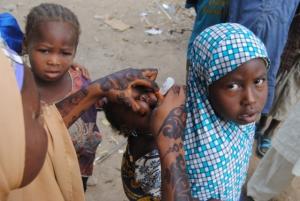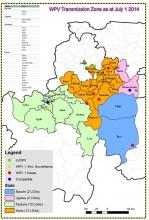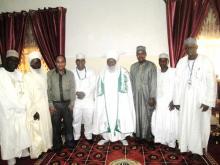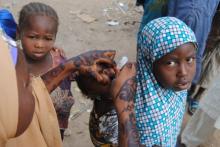Knocking Off remaining Polio "Sanctuaries": Active Transmission Zone Concludes Synchronized Outbreak Response
Abuja, 17 October, 2014 - The January 2012, Global Polio Independent Monitoring Board (IMB) report delineated four distinct polio virus “sanctuaries” in Nigeria, ‘places in which polioviruses had taken safe refuge’. The sanctuaries in the northern states were Borno (Borno- Yobe), Kano (Kano-Kaduna-Katsina) and Sokoto and Zamfara; homes to two-thirds of the polio cases detected in that year.
In the last six (6) months, the only sanctuary with confirmed active polio transmission is Kano-Kaduna with WPV1 isolated in Sumaila LGA in Kano on 24th July and WPV1 from Environmental Surveillance on 19th April, 2014.
In response, the National Polio Emergency Operations Center (EOC) demarcated 29 interstate LGAs in the sanctuary including LGAs in neighboring states of Jigawa and Bauchi as active polio transmission zone, spread across LGAs in the states which fit squarely into the definition, thereby putting the programme in a position of strength to focus on the residual challenges of reaching chronically missed children.
To ensure high quality of mop up response, the new strategy of Directly Observed Polio Vaccination (DOPV) was implemented with support from traditional, religious and community leaders; the fallout of an earlier advocacy visit by WCO and state officials led by the Immunization, Vaccines and Emergencies (IVE) Cluster Lead, Dr. Pascal Mkanda and Kaduna WHO State Coordinator, Dr Idowu Audu, to the very influential Emir of Zaria, Alhaji (Dr.) Shehu Idris in Kaduna state.
Taking its cue from there, Kaduna state immediately plunged into massive synchronized response and was in the vanguard for applying special strategies and innovations during the three rounds of the synchronized mop ups held in selected LGAs in July, September and October 2014. Activities implemented included the Directly Observed Polio Vaccination (DOPV) which has improved the quality of verifiable vaccinations especially in areas of uncertain immunization coverages.
The Incident Manager Kaduna State EOC, Dr Victor Gugong commended the effort of the national EOC in supporting the state’s drive towards achieving the goals of the outbreak response. He also acknowledged the supportive role of partners, especially WHO in the conduct of localized response to circulating Vaccine Derive Polio Virus (cVDPV) in 35 settlements across 10 wards of 5 LGAs, having tributaries of river/ drainages discharging into the environmental sampling sites in Zaria and Igabi LGAs.
In Bauchi, the volume of movement and various economic transactions, coupled with the threats of spread outside these sanctuaries, prompted the state to intensify market and motor parks immunization, which undoubtedly assisted in immunizing high value children on transit that are being missed during campaigns, as well as the systematic sensitization on AFP surveillance and vaccination in communities living along the border settlements.
To support Kano State, the epicenter of transmission, WHO prioritized deployment of staff from the central level and other states for planning, supervision and monitoring. Additionally, WHO is supporting plans in Kano to introduce Inactivated Polio Vaccine (IPV) in selected active transmission LGAs of Kano before end of 2014 to rapidly boost population immunity and stop transmission in this sanctuary.
These activities have thus far greatly contributed to 88% reduction in WPV1 cases with 6 confirmed cases in 2 States compared to 49 cases in 9 States for the same period in 2013, which situates Nigeria on the path of polio interruption. The significance of these strategies was acknowledged by the IMB during its last meeting held in London from 2-3 October, 2014 which was also attended by the WHO Country Representative, Dr. Rui Gama Vaz and senior government officials, as the much anticipated approaches to stop lingering polio transmissions in Nigeria.






